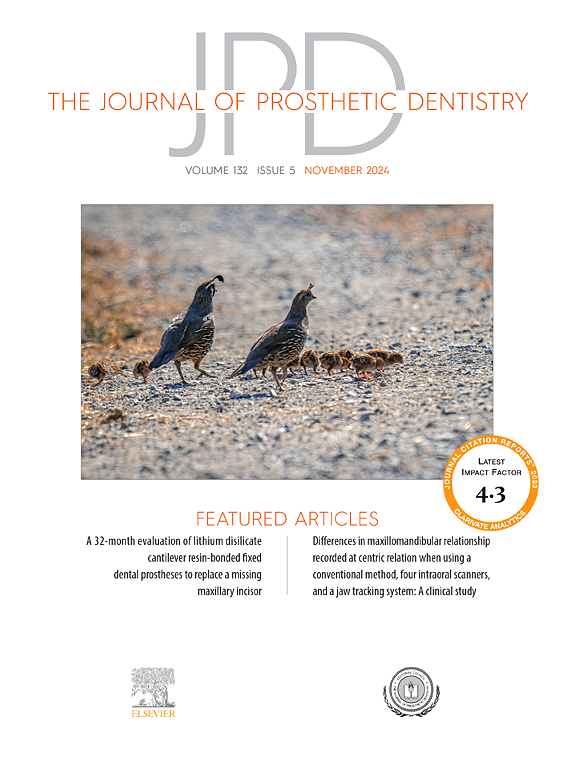使用数字扫描与传统印模技术制备的牙支撑固定修复体的边缘适应性:系统综述。
IF 4.8
2区 医学
Q1 DENTISTRY, ORAL SURGERY & MEDICINE
引用次数: 0
摘要
问题陈述:边缘适应对口腔健康和固定假体的寿命至关重要。传统的印模技术在精确的边缘复制和软组织管理方面经常面临挑战。尽管数字扫描提高了速度、方便性和精度,但这些优势是否转化为更好的边际适应能力仍未得到证实。目的:本研究的目的是分析比较使用数字扫描和传统印模制作的牙支撑固定修复体的边缘适应性的系统综述。材料和方法:在PubMed、Scopus、Web of Science、EMBASE和谷歌Scholar数据库中进行全面的文献检索,不受语言限制。该综述包括系统综述,有或没有荟萃分析,评估了数字扫描和传统印模制作在体内和体外固定假体边缘适应方面的初步研究。结果:18篇入选文章中,11篇纳入meta分析。10篇体内文章中的4篇和7篇体外文章中的4篇报告了数字扫描更好的边际适应。对于氧化锆,数字技术在5项体内研究中的4项(SMDs从-0.89到27.2)和所有体外研究中都优于传统方法。对于二硅酸锂和钴铬修复体,没有显着差异出现。关于假体类型,6项体内研究中有4项和5项体外研究中有3项支持单单元冠的数字扫描。对于部分固定假体,在体内和体外的3项研究中有2项支持数字优势。没有研究报告说传统的方法更好。然而,通过评估系统评价的方法学质量(AMSTAR) 2,大多数文章的质量被评为“极低”或“低”,这突出了方法学的局限性。结论:与传统印模制作相比,数字扫描提供了相当或更好的边缘适应,在氧化锆和单个或部分固定假体上表现出色。尽管存在成本和唾液干扰等挑战,但没有证据支持传统方法,将数字扫描定位为实际选择。未来的研究应该解决方法上的缺陷,以支持证据。本文章由计算机程序翻译,如有差异,请以英文原文为准。
Marginal adaptation of tooth-supported fixed restorations fabricated using digital scanning versus conventional impression techniques: An overview of systematic reviews
Statement of problem
Marginal adaptation is critical for oral health and the longevity of fixed prostheses. Conventional impression techniques frequently face challenges in accurate margin reproduction and soft tissue management. Although digital scanning offers enhanced speed, ease, and precision, whether these advantages translate into better marginal adaptation remains unproven.
Purpose
The purpose of this study was to analyze systematic reviews comparing the marginal adaptation of tooth-supported fixed restorations fabricated using digital scanning versus conventional impression making.
Material and methods
A comprehensive literature search, without language restrictions, was conducted in the PubMed, Scopus, Web of Science, EMBASE, and Google Scholar databases. The review included systematic reviews, with or without meta-analyses, evaluating primary studies on digital scanning and conventional impression making for marginal adaptation of fixed prostheses in in vivo and in vitro settings.
Results
Of the 18 selected articles, 11 included meta-analyses. Four of 10 articles in vivo and 4 of 7 articles in vitro reported better marginal adaptation with digital scanning. For zirconia, digital techniques outperformed conventional methods in 4 of 5 in vivo studies (SMDs from -0.89 to 27.2) and in all in vitro studies. For lithium disilicate and cobalt chromium restorations, no significant differences emerged. Regarding prosthesis types, 4 of 6 in vivo studies and 3 of 5 in vitro studies favored digital scanning for single-unit crowns. For partial fixed prostheses, 2 of 3 studies in both in vivo and in vitro settings supported digital superiority. No study reported that the conventional technique was better. However, most articles were rated "critically low" or "low" in quality by Assessing the Methodological Quality of Systematic Reviews (AMSTAR) 2, highlighting methodological limitations.
Conclusions
Digital scanning delivered equivalent or better marginal adaptation than conventional impression making, excelling with zirconia and for single or partial fixed prostheses. No evidence favored conventional methods, positioning digital scanning as a practical choice despite challenges like cost and saliva interference. Future studies should address methodological flaws to bolster evidence.
求助全文
通过发布文献求助,成功后即可免费获取论文全文。
去求助
来源期刊

Journal of Prosthetic Dentistry
医学-牙科与口腔外科
CiteScore
7.00
自引率
13.00%
发文量
599
审稿时长
69 days
期刊介绍:
The Journal of Prosthetic Dentistry is the leading professional journal devoted exclusively to prosthetic and restorative dentistry. The Journal is the official publication for 24 leading U.S. international prosthodontic organizations. The monthly publication features timely, original peer-reviewed articles on the newest techniques, dental materials, and research findings. The Journal serves prosthodontists and dentists in advanced practice, and features color photos that illustrate many step-by-step procedures. The Journal of Prosthetic Dentistry is included in Index Medicus and CINAHL.
 求助内容:
求助内容: 应助结果提醒方式:
应助结果提醒方式:


